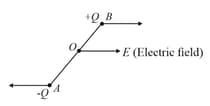EASY
Earn 100
What work must be done to rotate and electric dipole through an angle with the electric field, if an electric dipole of moment p is placed in an uniform electric field E with p parallel to E?
(a)
(b)
(c)
(d)None of these
33.33% studentsanswered this correctly
Important Questions on Electrostatics
EASY
EASY
EASY
MEDIUM
HARD
MEDIUM
MEDIUM
Define electric dipole moment. An electric dipole is placed within a uniform electric field and is rotated to an angle . Find out the work done.
MEDIUM
EASY
MEDIUM
EASY
MEDIUM
EASY
HARD
EASY
MEDIUM
EASY
In the figure the net torque acting on the dipole is

EASY
MEDIUM
HARD

